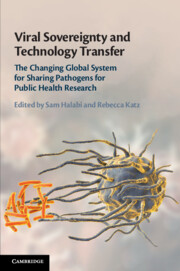 Viral Sovereignty and Technology Transfer
Viral Sovereignty and Technology Transfer Book contents
- Viral Sovereignty and Technology Transfer
- Viral Sovereignty and Technology Transfer
- Copyright page
- Contents
- Maps
- Tables
- Contributors
- Preface
- Acknowledgments
- Introduction Viral Sovereignty, Technology Transfer, and the Changing Global System for Sharing Pathogens for Public Health Research
- Part I The Geopolitical, Historical, and Scientific Context
- 1 The History of Accessing and Sharing Human Pathogens for Public Health Research
- 2 Attitudes towards Transfers of Human Research Samples across Borders
- 3 The Scope of Global Infectious Disease Research
- Part II Health Security, Research Ethics, and Human Rights Implications
- Part III Solutions: Standard Material Transfer Agreements, Repositories, and Specialized International Instruments
- Index
1 - The History of Accessing and Sharing Human Pathogens for Public Health Research
from Part I - The Geopolitical, Historical, and Scientific Context
Published online by Cambridge University Press: 15 May 2020
- Viral Sovereignty and Technology Transfer
- Viral Sovereignty and Technology Transfer
- Copyright page
- Contents
- Maps
- Tables
- Contributors
- Preface
- Acknowledgments
- Introduction Viral Sovereignty, Technology Transfer, and the Changing Global System for Sharing Pathogens for Public Health Research
- Part I The Geopolitical, Historical, and Scientific Context
- 1 The History of Accessing and Sharing Human Pathogens for Public Health Research
- 2 Attitudes towards Transfers of Human Research Samples across Borders
- 3 The Scope of Global Infectious Disease Research
- Part II Health Security, Research Ethics, and Human Rights Implications
- Part III Solutions: Standard Material Transfer Agreements, Repositories, and Specialized International Instruments
- Index
Summary
Chapter 1 explains how the history of accessing pathogens for public health research closely follows the history of accessing other (non-pathogenic) genetic resources for all forms of biological research. The genetic resources that were previously considered to be the common heritage of humankind are now subject to (sometimes conflicting) claims of intellectual property protections and sovereign rights. The result is the enclosure of pathogens in legal schemes that have increased costs and created delays in accessing the pathogen samples that are vital to conducting infectious disease surveillance, pharmaceutical research and development, and informing the public health response to outbreaks. While the validity of gene patents (and therefore patents claiming the genomes of pathogens or part thereof) are now in question, access to pathogens is still encumbered by an increasingly complex set of access and benefit-sharing laws that vary across domestic jurisdictions. This chapter examines these historical developments, explaining how pathogens were eventually captured by a regulation that was originally designed as an environmental conservation mechanism, and the impacts of “hyperownership” on accessing pathogen samples for public health research.
- Type
- Chapter
- Information
- Viral Sovereignty and Technology TransferThe Changing Global System for Sharing Pathogens for Public Health Research, pp. 31 - 44Publisher: Cambridge University PressPrint publication year: 2020
- 2
- Cited by


